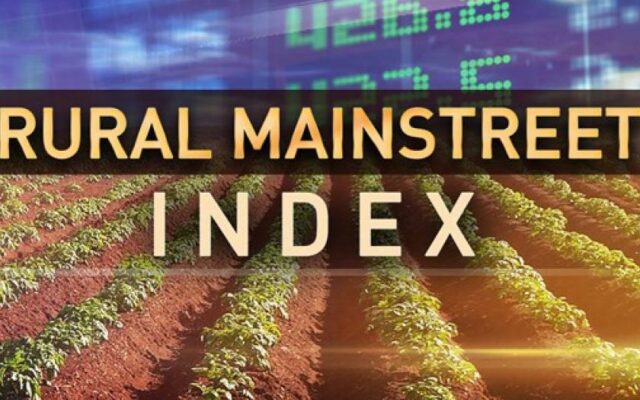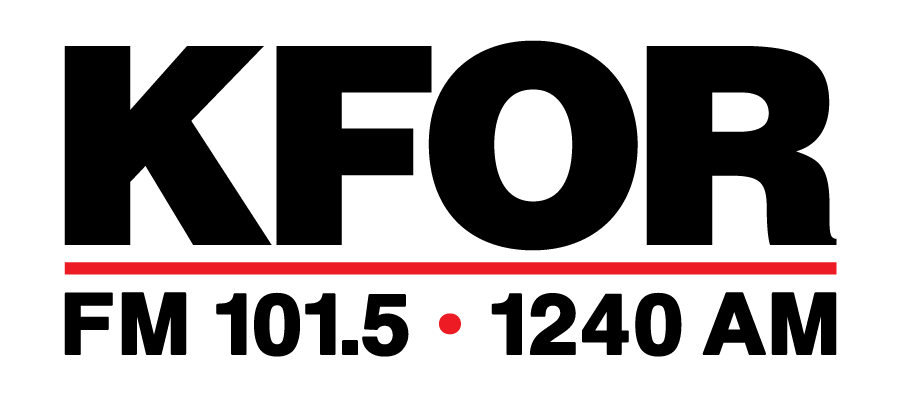Rural Mainstreet Economic Index Falls Below Growth Neutral Again

(KFOR NEWS August 19, 2022) The Creighton University Rural Mainstreet Index (RMI) fell for the fifth straight month, sinking below growth neutral for a third consecutive month according to the monthly survey of bank CEOs in rural areas of a 10-state region dependent on agriculture and/or energy.
Overall: The region’s overall reading for August slumped to 44.0 from 46.0 in July. The index ranges between 0 and 100 with a reading of 50.0 representing growth neutral. This was the fifth consecutive decline in the region’s overall reading.
“The Rural Mainstreet economy is now experiencing a downturn in economic activity. Supply chain disruptions from transportation bottlenecks and labor shortages continue to constrain growth. Farmers and bankers are bracing for escalating interest rates and falling farm commodity prices,” said Ernie Goss, PhD, Jack A. MacAllister Chair in Regional Economics at Creighton University’s Heider College of Business.
Bank CEOs were asked their assessment of the Inflation Reduction Act. On average, more than half, or 52.2%, expect spending and taxes related to the act to increase inflation and add to the federal deficit.
Among bankers naming drought as an area of concern, Jim Eckert, CEO of Anchor State Bank in Anchor, Ill., said that “in our area, crops generally look good but could use a rain. There are small pockets which are very dry. Without some timely rains, we will have an early harvest this year.”
Farming and ranching: The region’s farmland price index for August declined to 60.0 from July’s 66.0, marking the 23rd straight month that the index has moved above growth neutral. August’s solid reading was the lowest index since February 2021.
According to Jim Rothermich of the Land Talker, the average price per acre of Iowa farmland for the first half of 2022 increased from $12,480 to $13,852.
Bankers were asked about Chinese ownership of farmland and food processing in the region. More than nine of 10 bank CEOs, or 91.7%, regard Chinese purchases of farmland and food processing facilities in the region as a threat to the regional economy.
Farm equipment sales: The August farm equipment-sales index sank to 45.9 from 56.5 in July. After 20 straight months of advancing above growth neutral, the index unexpectedly dropped below the threshold to its lowest level since November 2020.
Banking: The August loan volume index climbed to a strong 73.9 from 72.0 in July. The checking-deposit index was unchanged from July’s 47.9, while the index for certificates of deposit and other savings instruments increased to 35.4 from 33.3 in July. “Higher costs of farm inputs and softer agriculture commodity prices supported stronger borrowing from farmers,” said Goss.
Even with significant 2022 input price increases over 2021 levels, bankers expect to record a 1.7% decline in farm loan delinquencies over the next 12 months.
Hiring: The new hiring index fell to 52.0 from 60.9 in July. Labor shortages continue to be a significant issue constraining growth for Rural Mainstreet businesses. Despite labor shortages, the Rural Mainstreet expanded non-farm employment by 3.4% over the past 12 months. This compares to an identical 3.4% expansion for urban areas of the same 10 states for the same period of time.
Confidence: The slowing economy, strong energy prices and agriculture input prices constrained the business confidence index to 38.0 in August, up from 26.0 in July.
Home and retail sales: The home-sales index dropped to a weak 44.0 from July’s 48.0. The retail-sales index for August improved to a weak 48.0 from July’s 46.0. “Rising energy prices and higher interest rates reduced home and retail sales on Rural Mainstreet. This is the lowest home sales index since December 2018,” said Goss.
The survey represents an early snapshot of the economy of rural agriculturally and energy-dependent portions of the nation. The Rural Mainstreet Index is a unique index covering 10 regional states, focusing on approximately 200 rural communities with an average population of 1,300. It provides the most current real-time analysis of the rural economy. Goss and Bill McQuillan, former chairman of the Independent Community Banks of America, created the monthly economic survey and launched it in January 2006.
Below are the state reports:
Colorado: Colorado’s Rural Mainstreet Index (RMI) for August rose to 56.8 from July’s 56.7. The farmland- and ranchland-price index climbed to 67.1 from 59.3 in July. Colorado’s hiring index for August fell to 60.3 from July’s 67.7. Over the past 12 months, U.S. Bureau of Labor Statistics (USBLS) data show that Colorado’s Rural Mainstreet Economy experienced a 6.0% increase in non-farm employment, while urban areas in the state gained 4.0% in non-farm employment.
Illinois: The August RMI for Illinois fell to 44.0 from 44.3 in July. The farmland-price index moved down to 61.7 from 66.9 in July. The state’s new-hiring index climbed to 61.7 from 61.2 in July. Over the past 12 months, USBLS data show that Illinois’ Rural Mainstreet Economy experienced a 3.1% increase in non-farm employment, while urban areas in the state gained 4.7% in non-farm employment.
Iowa: The August RMI for Iowa slumped to 40.1 from 45.1 in July. Iowa’s farmland-price index decreased to 63.5 from July’s 68.4. Iowa’s new-hiring index for August dropped to 55.9 from July’s 58.7. Over the past 12 months, USBLS data show that Iowa’s Rural Mainstreet Economy experienced a 3.6% increase in non-farm employment, while urban areas in the state gained 2.2% in non-farm employment.
Kansas: The Kansas RMI for August rose to 39.4 from July’s 38.7. The state’s farmland-price index dropped to 59.7 from July’s 64.5. The new-hiring index for Kansas slumped to 51.2 from 58.2 in July. Over the past 12 months, USBLS data show that Kansas’ Rural Mainstreet Economy experienced a 2.3% increase in non-farm employment, while urban areas in the state gained 1.9% in non-farm employment.
Minnesota: The August RMI for Minnesota sank to a regional-low 34.8 from 36.6 in July. Minnesota’s farmland-price index declined to 57.8 from July’s 63.6. The new-hiring index for August plummeted to 48.8 from July’s 57.1. Over the past 12 months, USBLS data show that Minnesota’s Rural Mainstreet Economy experienced a 1.5% gain in non-farm employment, while urban areas in the state added 3.5% in non-farm employment.
Missouri: The August RMI for Missouri decreased to a regional-high 58.3 from 63.0 in July. The farmland-price index was unchanged from July’s 69.7. The state’s hiring gauge increased to 63.6 from 63.4 in July. Over the past 12 months, USBLS data show that Missouri’s Rural Mainstreet Economy experienced a 7.3% gain in non-farm employment, while urban areas in the state gained 2.0% in non-farm employment.
Nebraska: The Nebraska RMI for August dropped below growth neutral to 47.8 from July’s 49.1. The state’s farmland-price index decreased to 63.3 from last month’s 68.9. Nebraska’s new-hiring index sank to 55.6 in August from 63.7 in July. Over the past 12 months, USBLS data show that Nebraska’s Rural Mainstreet Economy experienced a 4.1% gain in non-farm employment while urban areas in the state added 1.4% in non-farm employment.
North Dakota: The North Dakota RMI for August sank to 49.2 from 51.7 in July. The state’s farmland-price index plummeted to 63.9 from 70.0 in July. The state’s new-hiring index dropped to 56.4 from July’s 61.2. Over the past 12 months, USBLS data show that North Dakota’s Rural Mainstreet Economy experienced a 3.3% gain in non-farm employment while urban areas in the state expanded by 1.8% in non-farm employment.
South Dakota: The August RMI for South Dakota slumped to 37.3 from 38.4 in July. The state’s farmland-price index sank to 58.8 from 64.3 in July. South Dakota’s August hiring index measured 50.1 compared to 58.0 in July. Over the past 12 months, USBLS data show that South Dakota’s Rural Mainstreet Economy experienced a 1.5% gain in non-farm employment, while urban areas in the state added 3.0% in non-farm employment.
Wyoming: The August RMI for Wyoming declined to 44.0 from 46.5 in July. The July farmland- and ranchland-price index decreased to 61.7 from July’s 67.8. Wyoming’s new-hiring index declined to 53.6 from July’s 57.8. Over the past 12 months, USBLS data show that Wyoming’s Rural Mainstreet Economy experienced a 2.4% gain in non-farm employment, while urban areas in the state expanded by 1.5% in non-farm employment.
READ MORE: Police Plan Drive Sober or Get Pulled Over Traffic Enforcement Campaign






